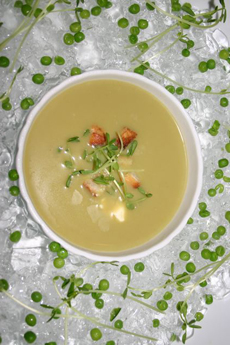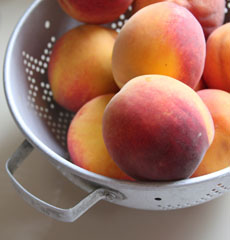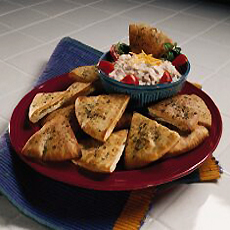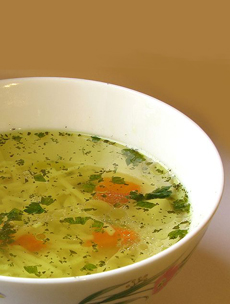|

[1] This cold (chilled) fresh pea soup recipe can be made with zucchini instead (photo © Gabriel Kreuther).

[2] For an elegant presentation, serve the bowl of chilled soup nestled into a bed of crushed ice. The chef scattered microgreens across the ice, but you can use snipped fresh herbs (photo © Meli Melo Restaurant [permanently closed]).
|
|
Chef Bernard Ros of Meli Melo Restaurant in New York City shares his recipe for Chilled Pea Soup With Goat Cheese Crumbles.
You can serve any of your favorite summer soups, from chilled cucumber soup, fresh tomato soup and gazpacho to vichyssoise, on a bed of crushed ice.
The crushed ice, on a small tray, large plate, or charger into which the soup bowl is set, creates an easy at-home presentation of chilled soup that looks like it was served at the finest restaurant.
Since fresh peas are seasonal and by early summer they may be gone, you can make this recipe from frozen peas.
Or skip the freezer and use fresh zucchini or yellow squash.
RECIPE: COLD PEA SOUP RECIPE or ZUCCHINI SOUP
Ingredients For 8 Servings
5 cups fresh green peas (you can substitute diced zucchini or summer squash, or use two 10-ounce packages of frozen peas)
4 cups chicken stock or broth
1 teaspoon kosher salt
1/2 teaspoon fresh-ground black pepper
4 cooked, diced potatoes
Salt and pepper to taste
4 ounces crumbled fresh goat cheese
Garnish(es): pea shoots, snipped chives, microgreens or
chiffonade of fresh mint
Optional: crushed ice for plating
Preparation
1. Bring chicken broth to boil. Add peas and cook for 3 to 5 minutes, until tender (do not overcook).
2. Purée in a food processor or blender. Add diced potatoes a scoop at a time and purée soup to desired consistency.
3. Refrigerate for three hours or overnight. Check prior to serving and adjust salt as needed.
4. Serve cold. To plate, place small bowls into large bowls or on dinner plates or chargers. Surround with crushed ice. Pour soup and add goat cheese and croutons. Garnish with herbs or pea shoots; sprinkle more garnish onto ice. Serve immediately.
|





